About war through contemporary art. Ukrainian artists have become more visible in the world
Over the past four years, the number of foreign exhibitions by contemporary Ukrainian artists has increased significantly. However, without proper support from the state, this achievement may be lost.
Why contemporary art is important
The Western world (here we will focus primarily on Europeans) values contemporary art. Money is invested in artworks, and galleries are considered an integral part of life. Patrons, collectors, and a wide range of admirers are interested in new names, the circumstances of their creativity, and the countries they represent.
While news reports about destruction and fighting in Ukraine have become routine, art is finding new ways to tell foreigners about our pain and struggle.
In October of this year, Ukraine was represented for the first time at the Art Basel Paris contemporary art fair, which brings together more than 200 contemporary art galleries from around the world every year. This provided Ukraine with "good press."
Materials about the Ukrainian Voloshyn Gallery, which is represented at the fair, appeared in six international media outlets, including the French Le Monde, the American Forbes, and one of the most prestigious art magazines, BeauxArts. In total, more than 30 international media outlets, from the New York Times to Monocle, have written about the gallery's work since the start of the full-scale invasion.
And this is just one example of a single gallery. Mentions in the media, particularly in professional art publications, expand the circle of people who learn about and remember the war in Ukraine. Is the number of people reading reports from the front lines and military analysis abroad growing? Most likely not. The audience for art content is more stable. Mentions of Ukrainian artists, Ukraine, and the war will indirectly spread information about us, which is also important.
The war factor
The war has been an important factor in the surge of interest in contemporary Ukrainian art. Some of Ukrainian artists found themselves in the US and EU countries at the start of the full-scale invasion. Ukrainian art abroad has experienced a boom of sorts: the number of exhibitions and projects by Ukrainian artists around the world has more than doubled.

Before the war, the largest centers of Ukrainian art were Kyiv, Lviv, and Odesa; however, in the first year of the war, American and European cities such as Miami, New York, Vienna, and Berlin also joined them.
After the full-scale invasion began, Ukrainian journalist Natalka Yakymovych opened the Serpen contemporary art gallery in Berlin. She believes that the war has contributed to the integration of Ukrainian artists into the global context: "People in Europe understand that Ukraine is part of European culture. This is very important."
Thanks to our contemporary art, people in Europe understand that Ukraine is part of European culture.
Natalka Yakymovych's opinion is shared by gallery owner Max Voloshyn, one of the founders of Voloshyn Gallery: "If Ukrainian art used to be something exotic and incomprehensible, now Ukraine has become a full-fledged member of the cultural process in Europe."
Art can serve as an indirect disseminator of information about the Russo-Ukrainian war.
From quantity to quality
After two years of full-scale Russian aggression, public attention to Ukrainian issues in the world began to wane. As a result, in 2024, the number of Ukrainian art exhibitions on different continents decreased to almost pre-war levels (statistics for 2025 are not yet available).
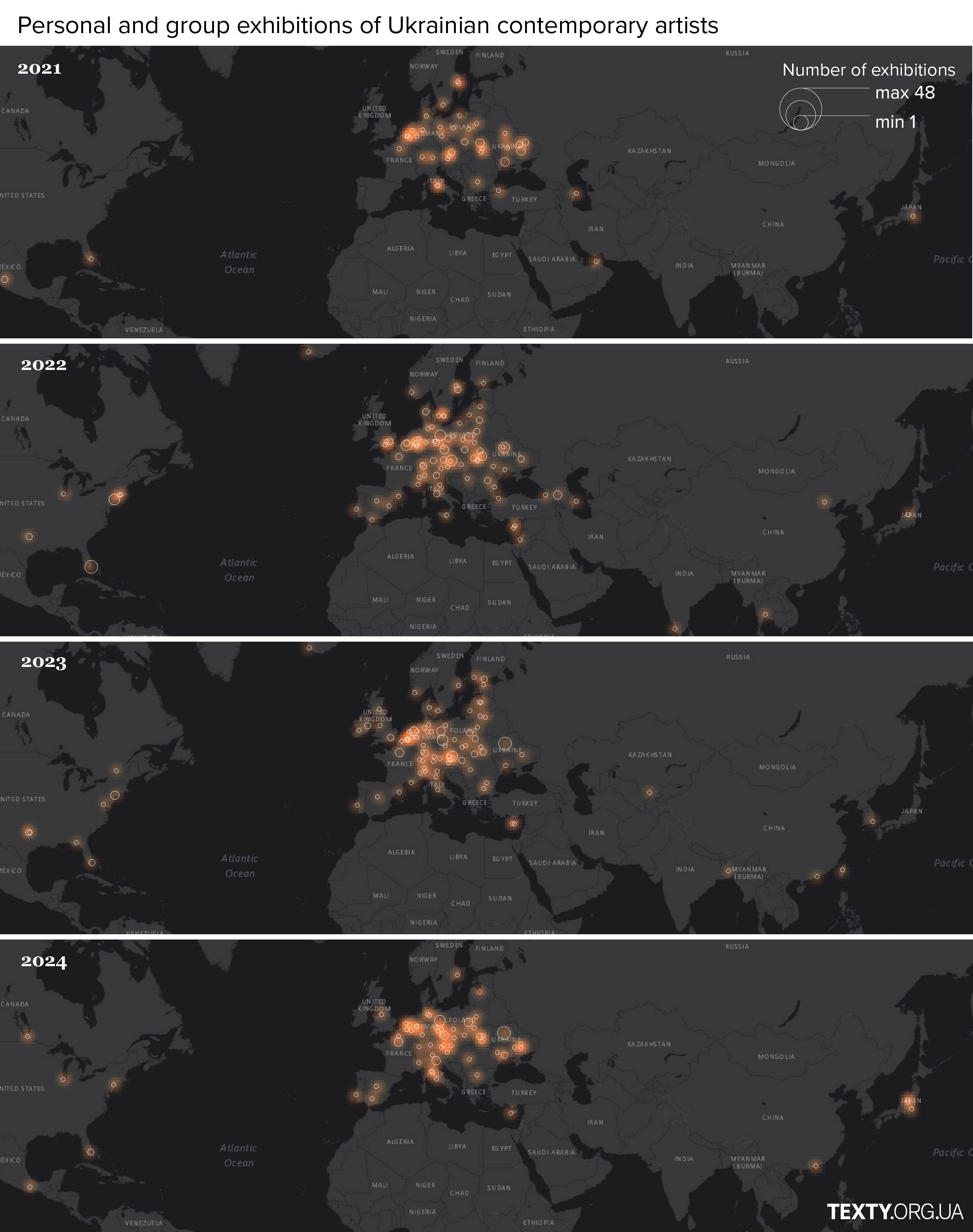

According to art expert Olha Balashova, at the beginning of the full-scale Russian invasion, Ukrainian artists dominated the international art scene in quantity. In 2024, they also made a mark with quality.
Ukrainian artist Nikita Kadan, in collaboration with Voloshyn Gallery, exhibited at the Frieze International Art Fair in New York this year. Ukraine participated in this exhibition for the first time. Kadan's works were even included in Frieze highlights — a list of artists whose paintings are a must-see.
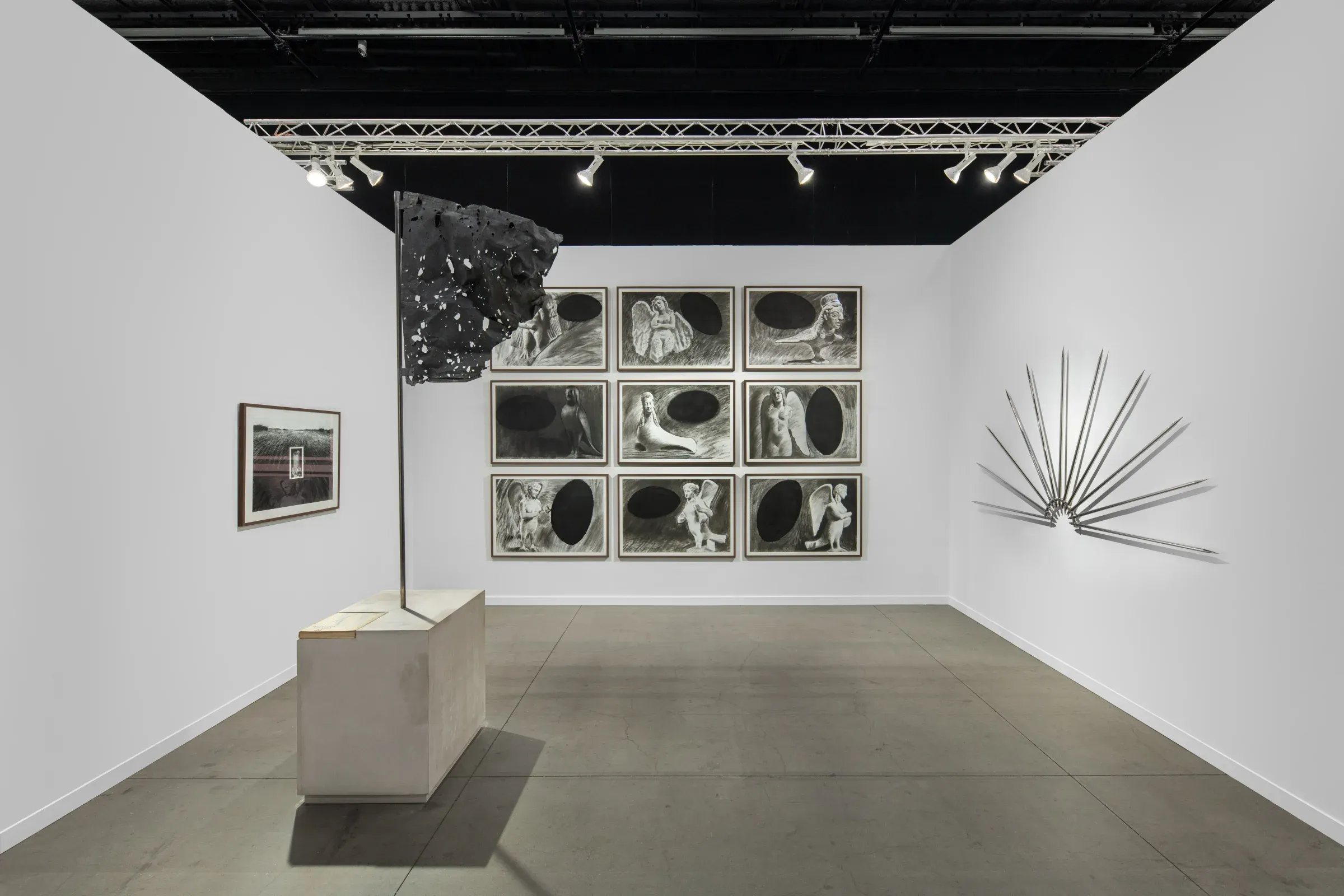
Voloshyn Gallery stand at the Frieze art fair in New York. Photo: Voloshyn Gallery
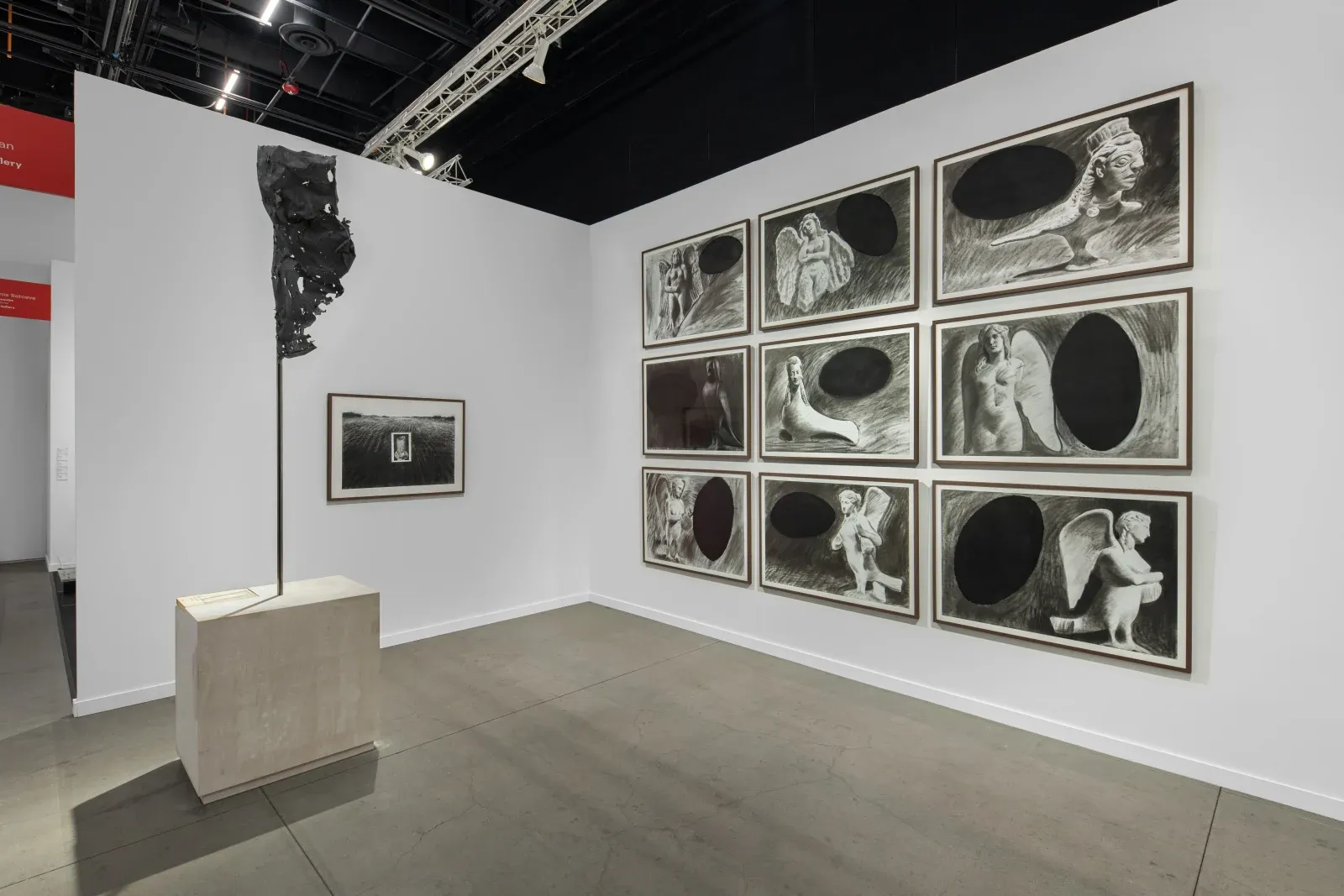
Voloshyn Gallery stand at the Frieze art fair in New York. Photo: Voloshyn Gallery
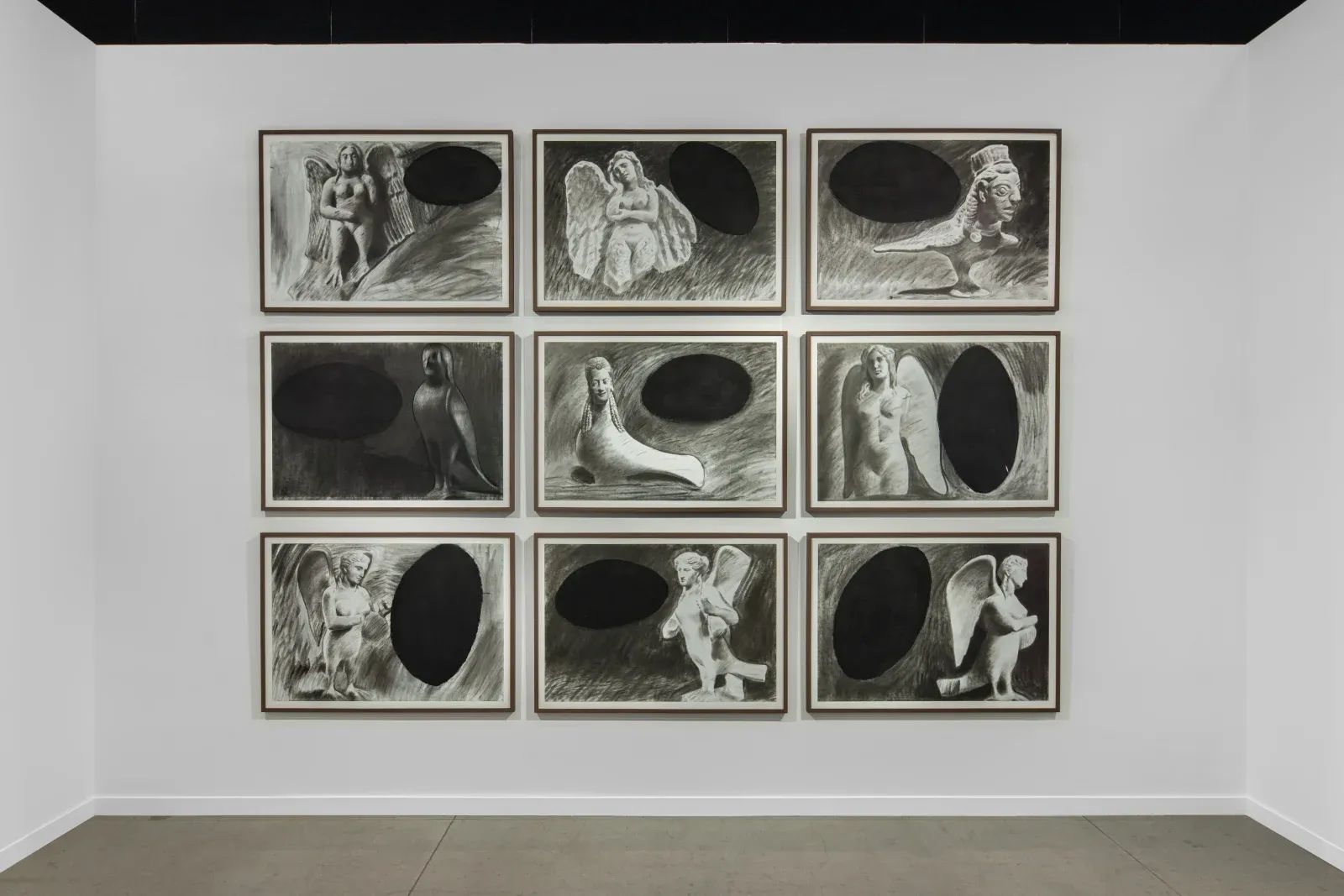
Voloshyn Gallery stand at the Frieze art fair in New York. Photo: Voloshyn Gallery
Zhanna Kadyrova is one of the most successful Ukrainian artists. The number of her exhibitions now consistently exceeds pre-war levels.
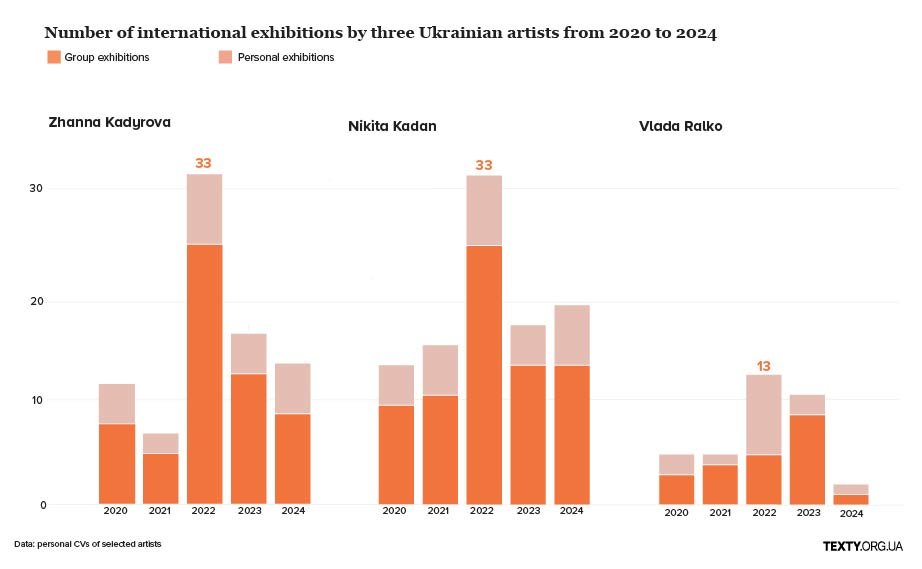
The international success of Zhanna Kadyrova, Nikita Kadan, and other Ukrainian artists is not only due to the attention Ukraine has received because of the war. Behind it lies the painstaking work of gallery owners, including planning exhibitions for years, constant negotiations with foreign partners, and collaboration with international institutions.
According to Zhanna Kadyrova, the institutional presence of Ukrainian art in the world has grown. This includes representation in museums, galleries, and catalogs; participation in leading fairs and exhibitions such as Frieze and Art Basel Paris; and collaboration with international foundations. The works of Ukrainian artists have attracted the attention of authoritative critics. All this strengthens the global position of domestic artists and increases the commercial appeal of their works. Consequently, Ukraine's opportunities are also growing.
However, behind this personal success, there is no sign of a systematic state policy.
The curse of naivety
While Russia aggressively promotes its visual arts, ballet, and the works of Pushkin, Ukraine lacks a clear cultural strategy abroad, according to art expert Olha Balashova.
"There is no understanding that art is cultural diplomacy, an ambassador that can speak about significant events and about culture itself. This is something without which a modern state cannot exist," she says.
Natalka Yakymovych notes that the issue with Ukraine's cultural policy is that it allocates budget funds to exhibitions that are disconnected from the global cultural context. Such projects are often are detrimental to the country, the journalist believes.
For example, grantors sometimes allocate funds for exhibitions of contemporary Ukrainian art abroad. Still, in reality, Ukraine brings "drawings of sunflowers made by kindergarten teachers."
Moving away from thoughtless projects
Ukraine must learn to play the long game in cultural policy. We still do not have a state-created or supported museum of contemporary art. For example, in neighboring Poland, the Muzeum Sztuki Nowoczesnej (MSN) has been in existence for 20 years. Incidentally, in 2025, the MSN hosted the Kyiv Biennale, which was organized in collaboration with the Kyiv Center for Visual Culture.
The Ukrainian Ministry of Culture should have a department of officials and managers who plan art events abroad years in advance. After all, exhibitions in Europe are prepared well in advance — a year, two years, or even more.
According to Julia Voloshyna, it is enough for Ukraine to hold one large European exhibition of contemporary art per year. At the same time, it should reduce the number of ill-conceived projects at embassies and save scarce resources.
During the war, it is obviously not easy to implement a sustainable cultural strategy abroad. However, if private institutions can do it, what is stopping the state?

